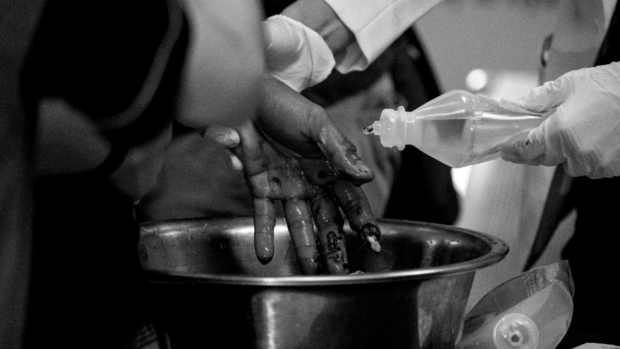4 dead, over 100 hurt as PH welcomes 2024

A person injured by firecrackers is cared for at the Jose Reyes Memorial Medical Center in Manila early on Jan. 1, 2019, after New Year’s celebrations. (Agence France-Presse)
MANILA, Philippines — Four people died while at least 116 others were injured, including an 11-month-old infant, amid the celebrations marking the New Year, according to Monday’s updates by the Department of Health (DOH) and the Philippine National Police.
This brought to 231 the number of fireworks-related injuries since Dec. 21, although the DOH said the count was likely higher.
More than half, or 126, of the injured were minors, the youngest being the infant in Metro Manila whose face and right eye were burned by a “piccolo” firecracker ignited by a reveler.
The oldest case was that of a 76-year-old man in the Ilocos region who hurt his right eye after he lit a “kwitis” (skyrocket) at home.
In Cagayan, a 68-year-old woman was injured in the chest after picking up kwitis left on the street in Barangay Linao East in the provincial capital of Tuguegarao, while a 42-year-old woman from Barangay Tagga also suffered minor burns after being hit by sparklers.
Article continues after this advertisementStill in Tuguegarao, an 11-year-old boy suffered minor burns on his left palm and index finger after lighting a “boga,” an improvised cannon.
Article continues after this advertisementAmputated
Not a few of the injuries were serious.
At least 11 of the wounded had to be amputated, including a 4-year-old boy in Central Luzon who lost all fingers in his right hand after lighting a “dart bomb,” an illegal firecracker.
The DOH said at least 65 people sustained eye injuries.
Most of the New Year’s Eve casualties were male, about half of whom used regulated or legal fireworks.
The DOH said the most common causes of firecracker injuries were kwitis, five-star, boga, piccolo, whistle bomb, “pla-pla,” luces, fountain, and triangle.
The five-star, boga, piccolo, and pla-pla firecrackers are prohibited, while the rest are legal.
Dr. Rosa Maria Rempillo, assistant regional director of the DOH in Bicol, said a 27-year-old man in Paracale, Camarines Norte, lost some of his fingers on both hands because of a pla-pla firecracker that he lit around 8 a.m. on Sunday.
In Naga City, provincial capital of Camarines Sur, a 54-year-old man needed to have a finger on his left hand cut out after he lighted a kwitis around midnight on Jan. 1.
The DOH Bicol recorded 21 cases of firecracker injuries, while the DOH in Calabarzon (Cavite, Laguna, Batangas, Rizal, Quezon) recorded seven cases.
Yet overall, the government’s campaign discouraging firecrackers was “satisfactory,” Health Secretary Teodoro Herbosa said, considering the 307 firecracker injuries last year.
Such injuries used to be as many as a thousand — such as the 1,021 casualties in 2011, when an average of 375 people were hurt daily from firecracker use.
The number gradually dropped to as low as the 123 reported cases in 2021, amid the COVID-19 restrictions still in place.
Indiscriminate firing
The PNP, meanwhile, reported two persons killed — one by a stray bullet, the other by a firecracker — but did not provide further details.
The DOH also reported five people injured by indiscriminate gun firing.
There were no deaths in the New Year’s Eve celebrations of 2021 and 2022, according to the PNP, which added that three police officers and two Army soldiers were involved in indiscriminate firing and are now in its custody.
Two children, ages 6 and 10, rounded up the remaining fatalities. They died in their home after a fire struck a government housing project in Barangay Ususan, Taguig City, on Sunday afternoon.
The Bureau of Fire Protection (BFP) in Taguig said the fire started from a “junked vehicle” in the residential complex shortly before 5 p.m. and was put out about 30 minutes later.
There were 19 other fires in Metro Manila on New Year’s Eve, the BFP said on Monday—the largest, razing a warehouse of online shopping items on Engineering Road in Barangay Potrero, Malabon City, in the wee hours of New Year’s Day.
Authorities said the fire was under control by 5:10 a.m., but it was not until Monday noon that it was put out.
The New Year’s Eve revelries were still by and large “generally peaceful,” the PNP said.